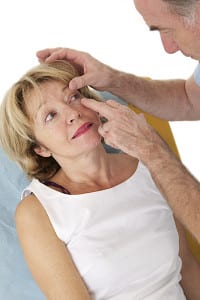
A typical eye exam will begin with the patient’s medical history. The doctor will want to know what types of issues you have had with your eyes in addition to a general medical history. The general medical history is a crucial component as there may be issues that, while not immediately related to vision, may still play a part in any number of visual impairments.
Though not all optometrists will follow the same order of tests in an eye exam, you can expect there to be the same general components regardless of who you choose to visit for your exam. The Snellen Eye Test is perhaps the most common diagnostic tool in a general eye exam. This simple test can quickly assess general visual acuity and provide the optometrist with a good idea of what type of correction, if any, is needed. The test is comprised of a chart with letters of different sizes that are to be read by the patient from a specified distance. The patient reads the smallest line of text that they can see without straining and repeat the letters they are able to read to the doctor.
In addition to the Snellen Eye Test, optometrists will often test for refraction. The way to test refraction is to use multiple lenses to see how those lenses improve the patient’s ability to read lines on the Snellen Eye Chart. The optometrist will go through several lenses and determine which makes the most difference for the patient. Another condition that doctors will test for is glaucoma. This is a condition wherein the pressure inside of the eye gets too high and can cause vision problem and be very painful. This test usually entails dilating the pupil, then examining the retina, which looks different when afflicted by glaucoma.
Now that you know what’s in a typical eye exam, make sure to set up an appointment with your optometrist and follow up annually to catch any impairments early on!




